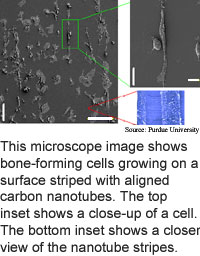
Aligned nanotubes accommodate
bone
Natural tissues grow from the ground up
molecule by molecule, and in many cases the alignment of each molecule
matters. Researchers from Purdue University have found that artificial
joints can be improved by mimicking the alignment of collagen fibers and
natural ceramic crystals in real bones.
Bones are made from proteins and ceramic crystals whose dimensions
are on the nanometer scale; the components of bone are also fiber-like.
With this in mind, the researchers are using nanoscale materials that
are fiber-like.
Today's nanotechnology techniques make it possible to orient carbon
nanotubes and filaments in implant material. Carbon nanotubes are rolled-up
sheets of carbon atoms that can be narrower than a nanometer, which is
one millionth of a millimeter, or the span of 10 hydrogen atoms.
The researchers' petri-dish experiments show that orienting artificial
joint material nanotubes in the same direction made bone cells attach
better to the material. It also stimulated the growth of more new bone
tissue, which is important for anchoring implanted artificial joints.
Finding better artificial joint material is motivated in part by the 15-year
lifespan of today's artificial joints.
Aligning the molecules in materials may also make them stronger,
according to the researchers.
The researchers used two methods to align nanotubes: aligning
a mix of nanotubes and plastic using electric current, and pouring nanotubes
into narrow channels on a silicon oxide surface.
The researchers had previously shown that bone-forming cells grow
more readily on carbon nanotubes materials than the titanium used in implants.
The material could be used in practical implants in 10 to 15 years,
according to the researchers. They presented the research at the Biomedical
Engineering Society annual meeting held in Philadelphia October 13 to
16, 2004.
Light clock promises finer time
Physics model predicts book sales
Silicon ring boosts light chips
Molecule harvests water's hydrogen
Briefs:
Virtual ring eases scrolling
DNA makes nanotube transistors
Scheme simplifies quantum chips
Aligned nanotubes accommodate bone
Light writes info into atoms
See-through circuits speed up

Research Watch blog
View from the High Ground Q&A
How It Works
RSS Feeds:
News
Ad links:
Buy an ad link
Ad links: Clear History
Buy an ad link
|
TRN
Newswire and Headline Feeds for Web sites
|
© Copyright Technology Research News, LLC 2000-2010. All rights reserved.